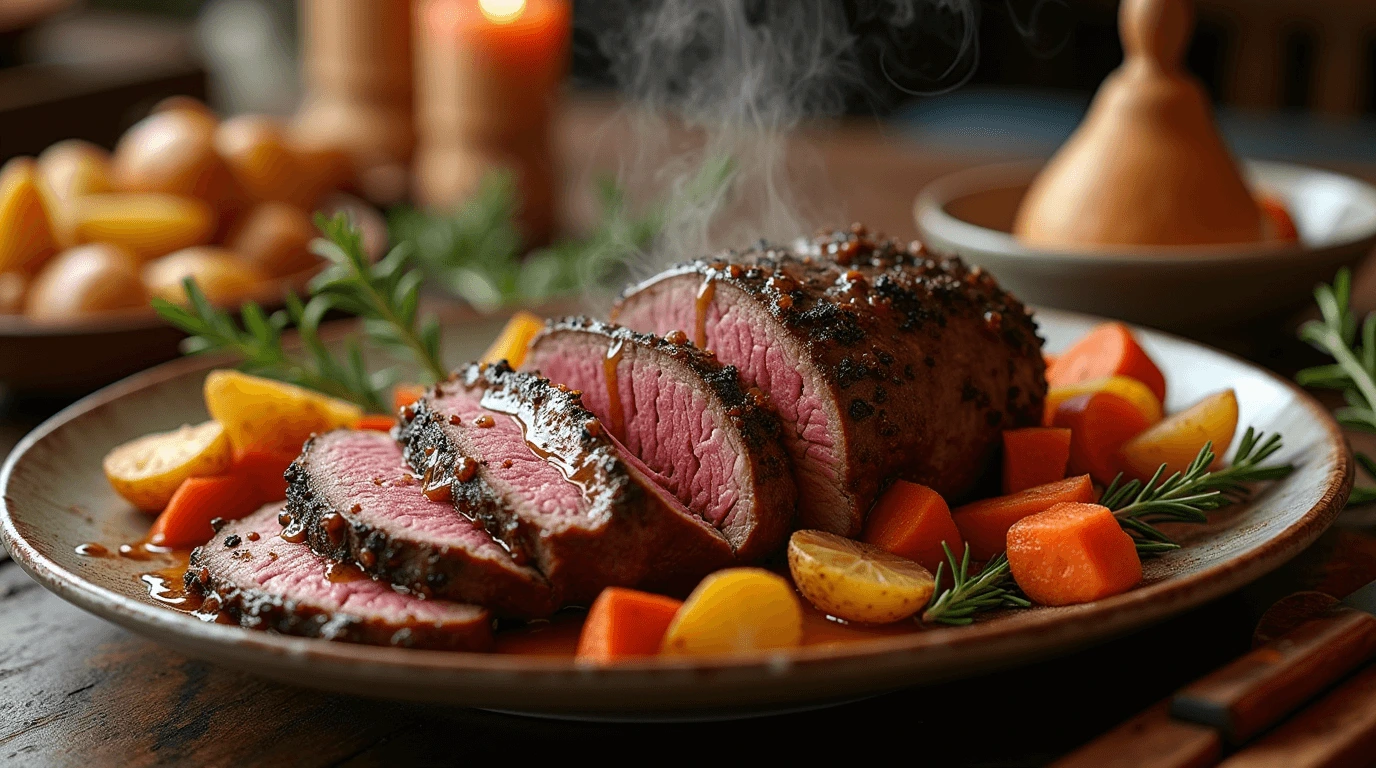Venison roast is a delicious and healthy alternative to traditional beef roast. Whether you’ve hunted your own deer or purchased high-quality venison, knowing how to prepare and cook it properly ensures a tender, flavorful meal. In this guide, we’ll walk you through every step of making the best venison roast at home, from choosing the right cut to perfecting your cooking technique.
Why Venison Roast is a Perfect Meal Choice
Venison is an excellent choice for those looking for a healthy, sustainable, and flavorful meal. Unlike traditional beef roasts, venison is naturally lean and packed with essential nutrients.
Health Benefits of Venison (Lean & High in Protein)
Venison is one of the leanest meats available, making it an excellent option for those watching their fat intake. It contains significantly less saturated fat than beef, yet it remains rich in protein, iron, and B vitamins. These nutrients support muscle growth, boost energy levels, and improve overall well-being. Additionally, venison has high levels of omega-3 fatty acids, which promote heart health.
Because venison is low in cholesterol, it’s an ideal protein source for individuals with cardiovascular concerns. Unlike farmed meats, wild venison is free from hormones, antibiotics, and artificial additives, making it a cleaner and healthier option. Eating venison regularly can help you maintain a healthy weight, improve metabolism, and reduce inflammation.
Sustainable and Ethical Eating (Wild Game Meat)
Choosing venison is a more sustainable and ethical alternative to factory-farmed meats. Deer are naturally free-range animals, meaning their diet consists of wild plants, grasses, and herbs rather than processed feed. Hunting for venison follows strict wildlife conservation laws, ensuring that populations remain balanced and that hunting practices are ethical.
For those who value organic and sustainable food sources, venison is an excellent choice. Unlike store-bought beef, venison requires minimal processing, reducing the carbon footprint of commercial meat production. Opting for wild game also helps promote biodiversity and responsible land management, making venison a conscious consumer’s ideal protein source.
Venison vs. Beef: Taste and Cooking Differences
Venison has a richer, slightly gamey flavor compared to beef. It absorbs seasonings well and pairs beautifully with herbs, garlic, and red wine. While beef contains more marbling (fat), venison is leaner, meaning it requires different cooking techniques to prevent dryness.
Cooking venison at a lower temperature for a longer period helps break down the fibers, making it tender and juicy. Unlike beef, which remains forgiving at various doneness levels, venison tastes best when cooked to medium-rare (135°F to 140°F). Cooking venison well-done can make it tough, so using slow cooking methods or marinades can help retain moisture.
Essential Ingredients for the Perfect Venison Roast
Discover premium venison cuts for roasting from trusted suppliers. Venison Meat Shop
To create a flavorful venison roast, selecting the right cut, marinade, and seasonings is crucial.
Best Cuts of Venison for Roasting (Hindquarter, Shoulder, Loin)
The best cuts for roasting include the hindquarter, shoulder, and loin. Each cut varies in texture and cooking method:
- Hindquarter (Leg Roast): Ideal for slow roasting or braising.
- Shoulder (Chuck Roast): Contains more connective tissue, making it perfect for slow-cooked stews or pot roasts.
- Loin (Backstrap): The most tender and flavorful cut, best roasted whole or grilled.
Must-Have Marinade Ingredients (Garlic, Thyme, Red Wine, Olive Oil)
Marinating venison enhances tenderness and adds rich flavors. A simple garlic and herb marinade can elevate the taste:
- Red wine: Adds depth and breaks down tough fibers.
- Olive oil: Helps retain moisture.
- Garlic and thyme: Complement venison’s natural flavors.
Seasoning Tips for Maximum Flavor (Salt, Pepper, Rosemary, Worcestershire Sauce)
A well-seasoned venison roast requires simple but bold spices.
- Salt & Pepper: Enhance natural flavors.
- Rosemary & Thyme: Provide an earthy aroma.
- Worcestershire Sauce: Adds umami depth.
Step-by-Step Guide to Cooking Venison Roast
Cooking venison requires proper preparation and slow cooking to achieve tenderness.
How to Properly Tenderize Venison Meat
Because venison is lean, tenderizing is essential:
- Use a marinade with acid (vinegar or citrus) to break down fibers.
- Slow cook at low temperatures to maintain moisture.
- Let it rest before slicing to allow juices to redistribute.
Slow Cooking vs. Oven Roasting: Which is Best?
- Slow Cooker (Crockpot): Great for fall-apart tenderness (6–8 hours).
- Oven Roasting: Best for loin cuts at 275°F for 2–3 hours.
Ideal Internal Temperatures for a Juicy Roast (135°F for Medium-Rare, 160°F for Well-Done)
- Medium-Rare: 135°F–140°F for a juicy, tender texture.
- Well-Done: 160°F+ (but may become dry).
Best Side Dishes to Serve with Venison Roast
Classic Roasted Vegetables
Roasting vegetables enhances their natural sweetness and complements the venison’s earthy flavor. Try:
- Carrots and parsnips
- Brussels sprouts
- Red potatoes and onions
Creamy Mashed Potatoes with Gravy
A rich and creamy side dish is the perfect pairing for venison roast, balancing the bold flavors with a smooth, buttery texture. To make extra indulgent mashed potatoes, start with high-starch potatoes like Russets or Yukon Golds for a fluffy consistency. Add butter and heavy cream to enhance the richness, while a touch of roasted garlic provides a deep, savory flavor. For the finishing touch, drizzle your mashed potatoes with homemade venison gravy, made from the pan drippings of your roast, for an extra layer of meaty goodness.
Wild Rice or Rustic Bread for a Hearty Meal
For a more rustic meal, consider:
- Wild rice with mushrooms
- Crusty bread to soak up delicious juices
- Buttered cornbread for a Southern touch
Pro Tips for a Flavorful and Tender Venison Roast
How to Avoid a Dry Venison Roast
- Always sear the meat before roasting to lock in juices.
- Cook at low temperatures to retain moisture.
- Use a basting method (drizzling with pan juices) every 30 minutes.
Resting Time: Why It’s Crucial for Juiciness
After cooking, let the venison roast rest for 10-15 minutes before slicing. This allows the juices to redistribute, making the meat more tender and flavorful.
Storing & Reheating Leftover Venison Roast
- Store in an airtight container in the fridge for up to 3 days.
- To reheat, use low heat (250°F) to avoid drying out the meat.
- Add a bit of broth or gravy while reheating to restore moisture.
Cooking the perfect venison roast at home is easier than you think when you follow the right techniques. By selecting the best cut, marinating properly, and cooking at the right temperature, you can enjoy a tender, juicy, and flavorful roast every time. Pair it with roasted vegetables, mashed potatoes, or wild rice for a hearty and satisfying meal. Try this recipe today and impress your family with a delicious homemade venison roast!


